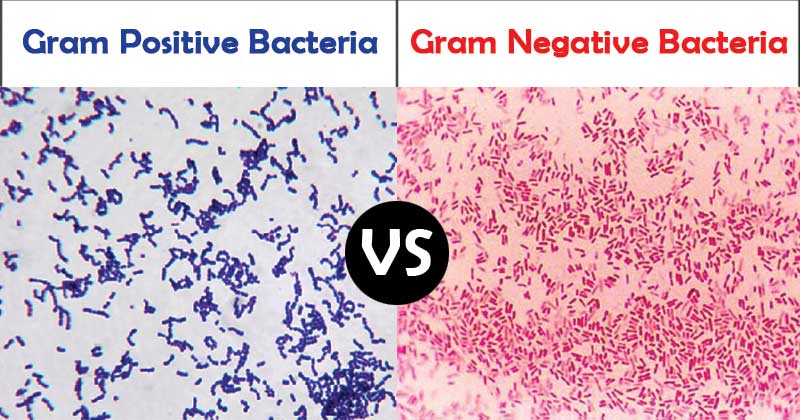
Interesting Science Videos
Gram Positive vs Gram Negative Bacteria (31 Major Differences)
| S.N. | Character | Gram-Positive Bacteria | Gram-Negative Bacteria |
| 1. | Gram Reaction | Retain crystal violet dye and stain blue or purple on Gram’s staining. | Accept safranin after decolorization and stain pink or red on Gram’s staining. |
| 2. | Cell wall thickness | Thick (20-80 nm) | Thin (8-10 nm) |
| 3. | Peptidoglycan Layer | Thick (multilayered) | Thin (single-layered) |
| 4. | Rigidity and Elasticity | Rigid and less elastic | Less rigid and more elastic |
| 5. | Outer Membrane | Absent | Present |
| 6. | Variety of amino acid in cell wall | Few | Several |
| 7. | Aromatic and Sulfur-containing amino acid in cell wall | Absent | Present |
| 8. | Periplasmic Space | Absent | Present |
| 9. | Teichoic Acids | Mostly present | Absent |
| 10. | Porins | Absent | Present |
| 11. | Lipopolysaccharide (LPS) Content | Virtually None | High |
| 12. | Lipid and Lipoprotein Content | Low (acid-fast bacteria have lipids linked to peptidoglycan) | High (because of the presence of outer membrane |
| 13. | Ratio of RNA:DNA | 8:1 | Almost 1 |
| 14. | Mesosomes | Quite Prominent | Less Prominent |
| 15. | Flagellar Structure | 2 rings in basal body | 4 rings in basal body |
| 16. | Magnetosomes | Usually absent. | Sometimes present. |
| 17. | Morphology | Usually cocci or spore-forming rods (exception: Lactobacillus and Corynebacterium) | Usually non-spore-forming rods (Exception: Neisseria) |
| 18. | Endospore formation | Some produce endospores during unfavorable conditions. | Usually not found to produce endospores. |
| 19. | Toxin Produced | Exotoxins | Endotoxins or Exotoxins |
| 20. | Pathogens | Few pathogenic bacteria belong to the Gram-positive group. | Most pathogens are Gram-negative. |
| 21. | Nutritional Requirements | Relatively Complex | Relatively Simple |
| 22. | Resistance to Physical Disruption | High | Low |
| 23. | Cell Wall Disruption by Lysozyme | High | Low (requires pretreatment to destabilize outer membrane) |
| 24. | Susceptibility to Penicillin and Sulfonamide | High | Low |
| 25. | Susceptibility to Streptomycin, Chloramphenicol, and Tetracycline | Low | High |
| 26. | Inhibition by Basic Dyes | High | Low |
| 27. | Susceptibility to Anionic Detergents | High | Low |
| 28. | Resistance to Sodium Azide | High | Low |
| 29. | Resistance to Drying | High | Low |
| 30. | Rendering | They can render Gram -ve by increasing acidity | They can render Gram +ve by increasing alkalinity |
| 31. | Examples | Staphylococcus Streptococcus Bacillus Clostridium Enterococcus Listeria | Escherichia Salmonella Klebsiella Proteus Helicobacter Pseudomonas |
Examples of Gram-positive cocci bacteria
Aerococcus species
Enterococcus faecalis
Enterococcus faecium
Gemella species
Lactococcus species
Leuconostoc species
Pediococcus species
Peptococcus niger
Peptostreptococcus species
Peptoniphilus species
Staphylococcus aureus
Staphylococcus epidermidis
Staphylococcus intermedius
Staphylococcus lugdunensis
Staphylococcus saprophyticus
Streptococcus agalactiae (Group B)
Streptococcus canis (Group G)
Streptococcus gallolyticus (Group D, formerly S. bovis)
Streptococcus infantarius (Group D, formerly S. bovis)
Streptococcus pneumoniae
Streptococcus pyogenes (Group A)
Streptococcus anginosus
Streptococcus constellatus
Streptococcus intermedius
Streptococcus mitis
Streptococcus mutans
Streptococcus salivarius
Streptococcus sanguis
Abiotrophia species (nutritionally variant streptococci)
Granulicatella species (nutritionally variant streptococci)
Examples of Gram-positive bacilli bacteria
Actinomyces israelii
Arcanobacterium species
Bacillus anthracis
Bacillus cereus
Bifidobacterium species
Clostridium botulinum
Clostridium difficile
Clostridium perfringens
Clostridium tetani
Corynebacterium diphtheriae
Corynebacterium jeikeium
Corynebacterium urealyticum
Eggerthella species
Erysipelothrix rhusiopathiae
Eubacterium species
Gardnerella vaginalis
Gordonia species
Lactobacillus species
Listeria monocytogenes
Mycobacterium abscessus
Mycobacterium avium
Mycobacterium bovis
Mycobacterium chelonae
Mycobacterium fortuitum
Mycobacterium intracellulare
Mycobacterium kansasii
Mycobacterium leprae
Mycobacterium marinum
Mycobacterium tuberculosis
Nocardia asteroides
Propionibacterium acnes
Rhodococcus equi
Tropheryma whippeli
Tsukamurella species
Examples of Gram-negative cocci bacteria
Moraxella catarrhalis
Neisseria gonorrhoeae
Neisseria meningitidis
Veillonella parvula
Examples of Gram-negative bacilli bacteria
Acinetobacter species
Aeromonas caviae
Aeromonas hydrophila
Aeromonas veronii biovar sobria
Alcaligenes species
Bacteroides ovatus
Bacteroides distasonis
Bacteroides thetaiotamicron
Bacteroides vulgatus
Brevundimonas species
Burkholderia cepacia
Burkholderia mallei
Burkholderia pseudomallei
Chryseobacterium species
Citrobacter freundii
Citrobacter koseri
Comamonas species
Cronobacter sakazakii
Edwardsiella tarda
Eikenella corrodens
Enterobacter aerogenes
Enterobacter cloacae
Escherichia coli
Fusobacterium necrophorum
Fusobacterium nucleatum
Klebsiella granulomatis
Klebsiella oxytoca
Klebsiella pneumoniae
Klebsiella pneumoniae subspecies rhinocscleromatis
Mobiluncus species
Moraxella species
Morganella morganii
Pasteurella multocida
Plesiomonas shigelloides
Porphyromonas species
Prevotella melaninogenica
Proteus mirabilis
Proteus vulgaris
Providencia alcalifaciens
Providencia rettgeri
Providencia stuartti
Pseudomonas aeruginosa
Pseudomonas fluorescens
Pseudomonas species
Ralstonia pickettii
Roseomonas species
Salmonella Choleraesuis
Salmonella Paratyphi A
Salmonella Paratyphi B
Salmonella Typhi
Serratia liquefaciens
Serratia marcescens
Shewanella putrefaciens
Shigella boydii
Shigella dysenteriae
Shigella flexneri
Shigella sonnei
Sphingobacterium species
Sphingomonas species
Stenotrophomonas maltophilia
Vibrio cholerae
Vibrio parahaemolyticus
Vibrio vulnificus
Yersinia enterocolitica
Yersinia pestis
Yersinia pseudotuberculosis
Examples of Gram-negative bacilli and coccobacilli bacteria
Aggregatibacter (Actinobacillus) actinomycetemcomitans
Aggregatibacter (Haemophilus) aphrophilus
Arcobacter species
Bartonella bacilliformis
Bartonella henselae
Bordetella bronchiseptica
Bordetella parapertussis
Bordetella pertussis
Brucella melitensis
Campylobacter fetus
Campylobacter jejuni
Capnocytophaga species
Cardiobacterium hominis
Chlamydia trachomatis
Chlamydophila pneumoniae
Chlamydophila psittaci
Ehrlichia chaffeensis
Francisella tularensis
Haemophilus aegyptius
Haemophilus ducreyi
Haemophilus influenzae
Haemophilus parainfluenzae
Helicobacter pylori
Kingella kingae
Legionella micdadei
Legionella pneumophila
Orientia tsutsugamushi
Streptobacillus moniliformis
References
Carroll K.C., & Hobden J.A., & Miller S, & Morse S.A., & Mietzner T.A., & Detrick B, & Mitchell T.G., & McKerrow J.H., & Sakanari J.A.(Eds.), (2019). Jawetz, Melnick, & Adelberg’s Medical Microbiology, 27e. McGraw Hill.

Thx a lot 😊
It’s too helpful for us
Thank you
Well organized information
Very sweeeet!
God bless you dear
Thanks so much
Thanks so much
interesting! .Thanks!.
Thanks
Mesosomes do not exist. Please stop using this term when it is proven to be not existing for about 40 years or more already.
Thank you, But its still in use in developing countries 🙂